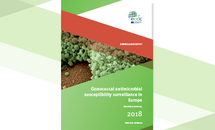Gonococcal antimicrobial susceptibility surveillance in Europe, 2018
The surveillance of Neisseria gonorrhoeae antimicrobial susceptibility in the European Union/European Economic Area (EU/EEA) has been co-ordinated by the European Centre for Disease Prevention and Control (ECDC) since 2009. This surveillance is essential for detecting emerging and increasing antimicrobial resistance and making quality-assured data available to inform treatment guidelines.
Executive Summary
During 2018, the European Gonococcal Antimicrobial Surveillance Programme (Euro-GASP) followed an annual decentralised and centralised testing model, requesting participating laboratories to collect gonococcal isolates during the period September–November. Susceptibility testing was performed on all isolates – MIC gradient strip test (mostly Etest) or agar dilution – for the following antimicrobials: ceftriaxone, cefixime, azithromycin, and ciprofloxacin, as well as testing for β-lactamase production for the detection of high-level penicillin resistance. Decentralised testing took place at participating laboratories that met a defined set of quality criteria.
In 2018, 27 EU/EEA Member States participated in Euro-GASP, 19 via decentralised testing. In total, 3 299 isolates were tested, the majority of which (85.3%) were collected from male patients. The age of the patients ranged from under one year to 86 years, with a median age of 30 years. Overall, 28.0% of patients were under 25 years, and males were significantly older than females. The anatomical site of specimen collection was mainly genital (70.4%), followed by rectal (18.6%) and pharyngeal (8.5%). Among cases with information on previous diagnosis of gonorrhoea, 26.9% had previously been diagnosed with the infection. Twenty-two percent of the patients were concurrently diagnosed with Chlamydia trachomatis infection. Among cases with known sexual orientation and gender (68.6%), 47.6% were heterosexual men or women, and 52.4% were men who have sex with men (MSM). Among all cases, 15.7% were HIV positive, and 92.4% of those were MSM.
In 2018, three isolates with resistance to ceftriaxone (two MIC=0.25 mg/L, one MIC=0.5 mg/L) were detected, one in Germany and two in Spain. One of the three ceftriaxone-resistant isolates had an azithromycin MIC over the epidemiological cut-off (MIC=16 mg/L) with susceptibility to increased exposure of ciprofloxacin (MIC=0.064 mg/L). The other two isolates had azithromycin MICs below the ECOFF (MIC=0.5 mg/L and 0.25 mg/L), both of which were resistant to ciprofloxacin (MIC≥32 mg/L). The 2018 Euro-GASP results revealed stable cefixime resistance (MIC>0.125 mg/L) at 1.4% compared to 2017 (1.9%), with a stable number of countries reporting any resistant isolates (n=12). There was a significant increase in the number of isolates with azithromycin MICs above 0.5 mg/L (i.e. the previously recommended EUCAST azithromycin resistance breakpoint); 7.5% of the isolates observed in 2016 and 2017 showed azithromycin MICs above 0.5 mg/L, compared to 13.3% in 2018 (p<0.0002). Since January 2019, the EUCAST clinical resistance breakpoint for azithromycin of MIC>0.5 mg/L has been
replaced with an ECOFF of MIC>1 mg/L. Using also the EUCAST ECOFF, a significant increase in the proportion of isolates above this ECOFF was observed: from 3.7% in 2017 to 7.6% in 2018 (p<0.0002). In 2018, 24 countries reported isolates with azithromycin MICs >0.5mg/L, compared to 23 countries in 2017, and 21 and 18 countries in 2016 and 2015, respectively. The proportion of isolates showing ciprofloxacin resistance significantly increased from 46.5% in 2017 to 50.3% in 2018 (p<0.01).
The decreasing azithromycin susceptibility combined with the appearance of ceftriaxone resistance is a major concern and threatens the effectiveness of the currently highly effective dual-therapy regimen (ceftriaxone plus azithromycin). Even though the level of resistance to cefixime is stable, cefixime resistance needs to be monitored closely, particularly because gonococcal strains with resistance to both cefixime and ceftriaxone continue to spread internationally. The continuation of quality-assured antimicrobial susceptibility surveillance activities, along with the development of alternative gonococcal regimens, is essential to ensure gonorrhoea remains a treatable infection.
Download

Erratum: this report originally stated incorrectly on page 15 that ‘As in 2017, the most common treatment was azithromycin alone…’ This was corrected on 11 November 2021 to read: ‘As in 2017, the most common treatment was ceftriaxone alone…’






